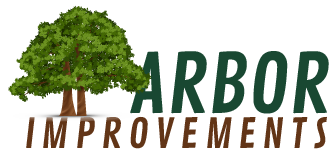Trees are an asset that add shade, beauty, and curb appeal to your property. Understanding the difference between a healthy tree and a damaged tree is essential to ensuring that you are keeping your home and family safe. The first sign that you have a hazardous tree can often be found in the structure of the tree itself. The experts at Arbor Improvements have provided the following tips to help you identify a damaged and potentially hazardous tree.
How Do You Know if a Tree is Hazardous?
Some visible signs that you have a potentially dangerous tree include root damage, cracked or damaged bark, dead wood, cankers, and decay.
1. Tree Root Problems: You can inadvertently damage tree roots by paving over them. A tree with a compromised root system can quickly become unstable and hazardous, making it much more likely to fall during high winds and inclement weather. Along with paving stones, damage to the root system can occur in several ways, such as parking vehicles over the roots and even natural root decay. One of the most common signs of root damage includes yellow or brown leaves that appear smaller than usual. Discolored leaves indicate that the roots are not providing enough nutrients or water to the tree. Contact the experts at Arbor Improvements if you notice a tree leaning to one side or the roots are exposed and decayed.
2. Damaged or Cracked Tree Bark: Bark acts like a coat of armor to protect the tree from damage by insects and disease. When the bark on a tree splits or cracks, it exposes the wood inside to the outside elements, making the tree susceptible to decay and potentially damaging its internal structure. If you notice deep cracks in the bark, dead branches, or a significant split or cracked branch, it could harm a person or property if it falls. Contact the experts at Arbor Improvements for assistance.
3. Deadwood: Dead and damaged wood within the tree’s crown can be dangerous, making it much more susceptible to storm damage. Dead wood can also be a sign of trunk decay. Since deadwood is inflexible, it can fall at any time. Undetached broken branches are hazardous as they can fail without warning. Early warning signs of deadwood include fewer leaves in the spring and summer, dead branches stuck in the tree’s crown, and large dead branches.
4. Tree Cankers: If you find damaged bark or tree areas that appear sunken, your tree may suffer from a canker disease. Cankers are caused by infection or wounded tissues failing to seal off decay, leading to extensive internal damage that can make your tree dangerous. If you notice weakened branches or a canker covering more than half of the tree’s trunk, contact your Arbor Improvements technician for assistance.
5. Tree Decay: One of the most notable signs of a hazardous tree is visible decay that has rapidly progressed. Mushrooms and fungus resembling a shelf (conks) or crumbling bark can indicate that the tree’s internal structure is also damaged. Internal decay is especially dangerous as the tree can continue to grow bark over the decayed areas. Eventually, the tree will fail, potentially causing injury and property damage. If you notice signs of decay around the branches or thin layers of new growth over decay, contact your Arbor Improvements expert for a professional evaluation.
Tree Trimming, Removal & More in Greenville, Greer, Mauldin, Simpsonville, Union and Spartanburg, SC
To learn more about Emergency Tree Removal, Trimming, Storm Damage Debris Cleanup & More in Greater Spartanburg, South Carolina, contact the experts at Arbor Improvements today.


